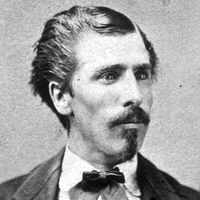All U Need
Your gateway to the Library Catalog, Digital Items, Library Website search results, and more simultaneously!
Your gateway to the Library Catalog, Digital Items, Library Website search results, and more simultaneously!


Danquart Anthon “Dan” Weggeland was born in Christiana, Norway, in 1827. He is known for his murals and his oil paintings. He died in Salt Lake City in 1918.
Because Weggeland showed an early interest in drawing, he apprenticed with a painter and decorator in Copenhagen for one year. He then studied at the Danish Royal Academy. In 1855, he became a convert to The Church of Jesus Christ of Latter-day Saints, in 1862 Weggeland immigrated to Utah.
One of Weggeland's strengths was recording history and genre. He painted murals for the St. George, Logan, and Manti Temples of The Church of Jesus Christ of Latter-day Saints; his best murals were painted for The Church's Salt Lake Temple.
Biography adapted from Artists of Utah.
Danquart Anthon Weggeland was born in Christiana, Norway, in 1827. As a child he was interested in drawing, and at 16 he was able to start art lessons with a local portrait painter. Four years later he left home for a year's apprenticeship with a painter and decorator in Copenhagen and then spent the next year studying at the Danish Royal Academy of Art.
Back in Norway, he supported himself with an odd assortment of jobs, took lessons in landscape painting, made a little money painting portraits, decorated some curtains for a theater, and studied costume design to improve his figurative work.
In 1854, Weggeland agreed to attend a meeting of the recently organized Stavanger branch of the Church of Jesus Christ of Latter-day Saints, where he met another aspiring artist, C. C. A. Christensen. Within a year of their meeting, Weggeland became a member of the LDS church. Christensen and Weggeland both eventually emigrated to Utah and remained lifelong friends.
Dan Weggeland moved to England and served a mission for the Church there from 1857 to 1861, and then he emigrated to America. While working to earn money to move west, he studied with Daniel Huntington and George P. A. Healy, two of the most successful portrait painters in the East. These two artists both used a refined, smooth technique that influenced Weggeland's style of portraiture and gave his later portraits an elegance not found in most of his Utah contemporaries' work.
In 1862, Weggeland finally had enough money to travel to Salt Lake City, arriving in September. For the next 11 years he helped pay his rent by painting scenery for the Salt Lake Theater, and he used sketches from the trek west and drawings of Utah landscapes to create paintings that are more fluid and painterly than those of other Utah artists of his time.
Weggeland's greatest strength as an artist lay in his ability to record everyday life. He used this strength in producing murals for four LDS temples: St. George, Logan, Manti, and Salt Lake, with his best work in the Salt Lake Temple. Although better than Christensen at composing figures, he was not as effective at producing solidly modeled forms nor at conveying personality.
On the other hand, Weggeland was a great teacher of art and a founder of the Deseret Academy. Later he was called "The Father of Utah Art," and was one of the most important influences on the second generation of Utah artists: J. T. Harwood, Edwin Evans, John Hafen, Lorus Pratt, and Phineas H. Young.
Because of the quality of his work, his progressive style, and his influence on other artists, Dan Weggeland was probably the most important early Utah painter. He continued to teach in Utah and to exhibit nationally, winning gold and silver medals at the Chicago Columbian Exposition of 1893. He stayed current with artistic direction on a national level and was greatly respected by younger artists, many of whom he influenced to study in Paris, helping to establish an important tradition of European-trained native Utah artists.
Biography courtesy of The Springville Museum of Art.
Newspaper Articles
"Caption Only: Utah Artists." The Deseret News, February 24, 2002.
"Days of '47 Art Show." The Deseret News, July 19, 1998.
"View Pioneer Artist's Works." The Deseret News, September 7, 2000.
Books
Axelrod, Alan. Art of the Golden West. New York, NY: Abbeville Press, 1990.
Davenport, Ray. Davenport's Art Reference. Ventura, CA: Davenport's Art Reference, 2001.
Dawdy, Doris. Artists of the American West: A Biographical Dictionary. Chicago, IL: Sage Books, 1990.
Dunbier, Lonnie Pierson, ed. The Artists Bluebook: 29,000 North American Artists. Scottsdale, AZ: AskART.com, 2003.
Falk, Peter Hastings. Who Was Who in American Art, 1564-1975: 400 Years of Artists in America. Madison, CT: Sound View Press, 1999.
Falk, Peter Hastings. Who Was Who in American Art; Compiled from the Original thirty-four Volumes of American Art Annual: Who's Who in Art, Biographies of American Artists Active from 1898-1947. Madison, CT: Sound View Press, 1985.
Gerdts, William H. Art Across America: Two Centuries of Regional Painting, 1710-1920. New York, NY: Abbeville Press, 1990.
Haseltine, James L. 100 Years of Utah Painting: Selected Works from the 1840s to the 1940s. Salt Lake City, UT: Salt Lake Arts Center, 1965.
Olpin, Robert, S, William C. Seifrit, and Vern G. Swanson. Artists of Utah. Salt Lake City, UT: Gibbs Smith Publishing Co., 1999.
Samuels, Peggy and Harold Samuels. The Illustrated Biographical Encyclopedia of Artists of the American West. Garden City, NY: Doubleday, 1976.
Swanson, Vern G., Robert S. Olpin, Donna Poulton, and Janie Rogers. 150 Years Survey of Utah Art, Utah Artists. Layton, UT: Gibbs Smith Publishing Co., 2001.
Swanson, Vern G., Robert S. Olpin, and William C. Seifrit. Utah Painting and Sculpture. Layton, UT: Gibbs Smith Publishing Co., 1991.
Swanson, Vern G., Robert S. Olpin, and William C. Seifrit. Utah Art. Layton, UT: Peregrine Smith Books, 1991.